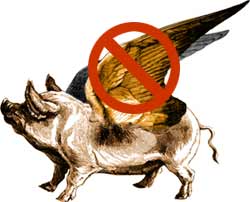A lineage’s development may limit the sorts of phenotypes that it can evolve. This limitation is called a developmental constraint.
The idea of constraint helps us explain why some things didn’t happen in evolution that we might think would be advantageous: why didn’t any tetrapods evolve more than five real fingers and toes, why didn’t caterpillars evolve to have the complex eye of adult butterflies, and why didn’t pigs evolve wings? Although difficult to figure out, the answers to these questions likely have to do with the developmental processes of tetrapods, insects, and pigs. Perhaps these features would fatally interrupt other aspects of the organism’s development — or perhaps these features would require so many other drastic changes in development that they are unlikely to arise through mutation.
To look at an example in more detail, horses (and all tetrapods — from sloths to salamanders) develop through a stage where the embryo has limbs with five digits, even though some of these will be lost or greatly modified. One might think that it would be advantageous for horses to develop hooves directly, but they don’t — they retain the five-digit developmental stage. The explanation for this may be developmental in nature — skipping the five-digit stage may simply not be an option in tetrapods’ developmental processes.

Read more about how development factored into the history of evolutionary thought.
Learn more about evolution and development in context: Why the eye?, a case study.
Teach your students about development:
- Mealworm metamorphosis, a classroom activity for grades 3-5.
Find additional lessons, activities, videos, and articles that focus on development.

